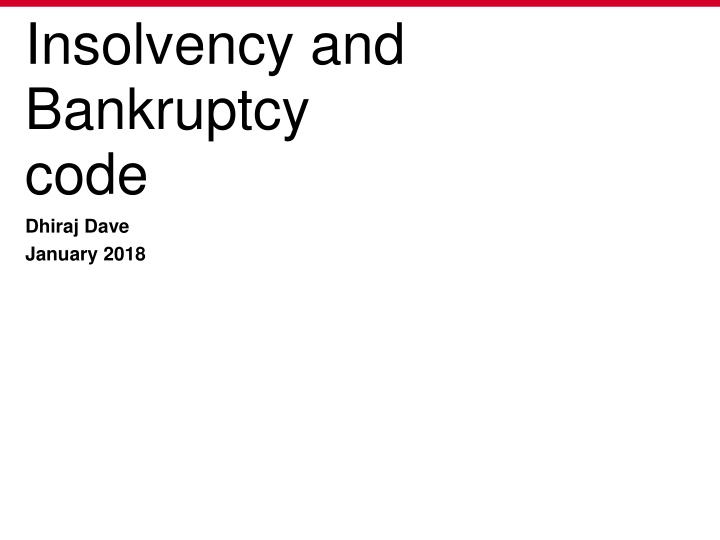
Insolvency and Bankruptcy Code
Explore the transformative effects of the Insolvency and Bankruptcy Code in India, including improved ease of doing business, restructuring processes, creditor advantages, and the infrastructure supporting the code. Learn about the changes, key entities involved, corporate insolvency resolution processes, and timelines under the code.
Download Presentation

Please find below an Image/Link to download the presentation.
The content on the website is provided AS IS for your information and personal use only. It may not be sold, licensed, or shared on other websites without obtaining consent from the author. If you encounter any issues during the download, it is possible that the publisher has removed the file from their server.
You are allowed to download the files provided on this website for personal or commercial use, subject to the condition that they are used lawfully. All files are the property of their respective owners.
The content on the website is provided AS IS for your information and personal use only. It may not be sold, licensed, or shared on other websites without obtaining consent from the author.
E N D
Presentation Transcript
Insolvency and Bankruptcy code Dhiraj Dave January 2018
Why Insolvency Code Improve Ease of Doing Business ranking for India High Stress level in Banking System Release Capital quickly from system for productive re-usage The average life of cases recommended for restructuring in 2002 was 7 years and the average life of cases recommended for winding up to the court was 6.5 years Consolidating various regulation under one umbrella Increasing share on bond in debt market in India Increasing confidence of international investor in Indian market Difficult regulation related to enforcement of security by Foreign lender which increase cost of borrowing for Indian borrower
Ease of doing business : Indias ranking Recovery rate 2018 Ranking 100 90 130 80 140 123 70 120 Rank 2018 Rank 2017 60 100 78 50 74 80 40 125 60 40 30 100 40 82 78 20 13 8 7 20 2 10 35 7 6 2 13 0 0 2018 Time year 2018 Rec Cost 5 4.3 4 25 4 22 20 18 3 2 1.7 0.9 1 1 0.8 2 15 2 12 10 9 10 1 9 6 5 4 3.5 0 0 3
What has changed? Insolvency test moved from erosion of net worth to payment default Single insolvency and bankruptcy framework. Replaces SICA Time bound resolution process Advantage Creditor - Shift of control from shareholders and promoters to creditors - Provide confidence to lenders of their rights and their enforcement. - Better symmetry of information flow between creditors and debtors - Government dues would rank below to those of secured creditors and unsecured financial creditors Insolvency Professional (IP) to take over the management and operations of the borrower during the CIRP Focus to get back fraudulent diversion of assets, personal contribution can be sought; imprisonment possible 4
Insolvency and Bankruptcy Code Infrastructure Insolvency and Bankruptcy Board Information Utility Insolvency Agency NCLT Insolvency Professional Committee of Creditor Insolvent Entity 5
Corporate Insolvency Resolution Process Default Appointment of a resolution professional Moratorium period (180/270 days) Formation of committee of Creditors No 75% of the creditor to approve Yes Returned to Management Yes RP Implementation Success No Goes into Liquidation
Corporate Resolution Timeline IRP to constitute CoC and submit Submission of plan report Application for NCLT approval First CoC meeting, IP Appointed Admission of Application, Moratorium Declared, NCLT Appoint Interim RP Creditor to submit claims No of Days 150 170 -ve 14 3 180 0 30 21 7 44 14 23 Appoint 2 Valuers Acceptance/ Rejection of Resolution plan by AA, Liquidation in process begin Preparation of IM Filing of application to NCLT Public announcement CoC s approval of resolution plan IRP Verify claim 7
Corporate Liquidation : Priority of claims Insolvency resolution process and liquidation cost Insolvency cost include funding cost for running the debtor as going concern Secured creditor and workman dues (upto 24 months) Secured creditor can opt for SARFAESI Action, No clarity on right of different class of creditor Other Employee dues (upto 12 months) Non Workman/ Contract labour Financial debt of unsecured Creditors ECB/ Fixed deposit Government dues (upto 2 years) and unpaid secured creditor SARFAESI lender residual claim Any other remaining debt Other dues of debtors Having Priority over Equity Preference shareholder Equity shareholder Least priority class 8
IBC: Equity investment perspective Market capCDR Debt Approval Date Company Lead Debt CDR SDR ABG Shipyard ICICI 9,290 Yes Yes 137 9,500 28-03-2014 Alok Industries SBI 22,075 No Yes 563 n.a. n.a. Amtek Auto Corporation 14,075 No No 745 n.a. n.a. Bhushan Power and Steel PNB 37,248 No No N.A. n.a. n.a. Bhushan Steel PNB 44,478 No No 1,572 n.a. n.a. Elestrosteel Steels SBI 10,274 Yes Yes 1,409 6,800 26-09-2013 Era Infra SBI 10,065 Yes No 50 5,000 18-01-2014 Essar Steel SBI 37,284 No No N.A. n.a. n.a. Jaypee Infratech IDBI 9,635 No No 3,271 n.a. n.a. Jyoti Structure SBI 5,165 No Yes 153 n.a. n.a. Lanco Infratech IDBI 44,365 Yes No 467 7,700 11-12-2013 Monnet Ispat SBI 12,115 No Yes 701 n.a. n.a. Total Debt, Market capitalisation and CDR Debt are in Rs crores. 2,53,732 9,068 9
IBC: Recovery record Synergies Dooray Resolution Plan Dues to Amount claimed (Rs Cr) Amount to be paid (Rs Cr) Recovery Remark Financial Creditor 972.15 54.69 5.63% Payments to be made in staggered manner over time, Additionally, shareholders of the corporate debtor got 0.48% shares of Synergy Castings Limited. Liquidation value estimate Rs 8.17 Cr 6.00% Operational Creditor 00.23 00.01 4.35% Government and Statutory dues 03.89 03.89 100.00% Total 976.27 58.59 Source: IBBI Newsletter Jul-Sep 2017 10
